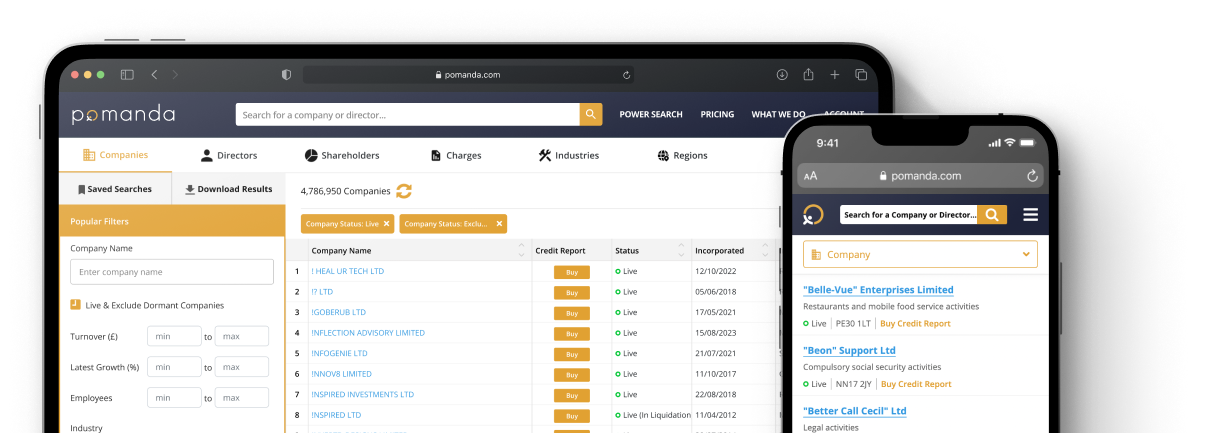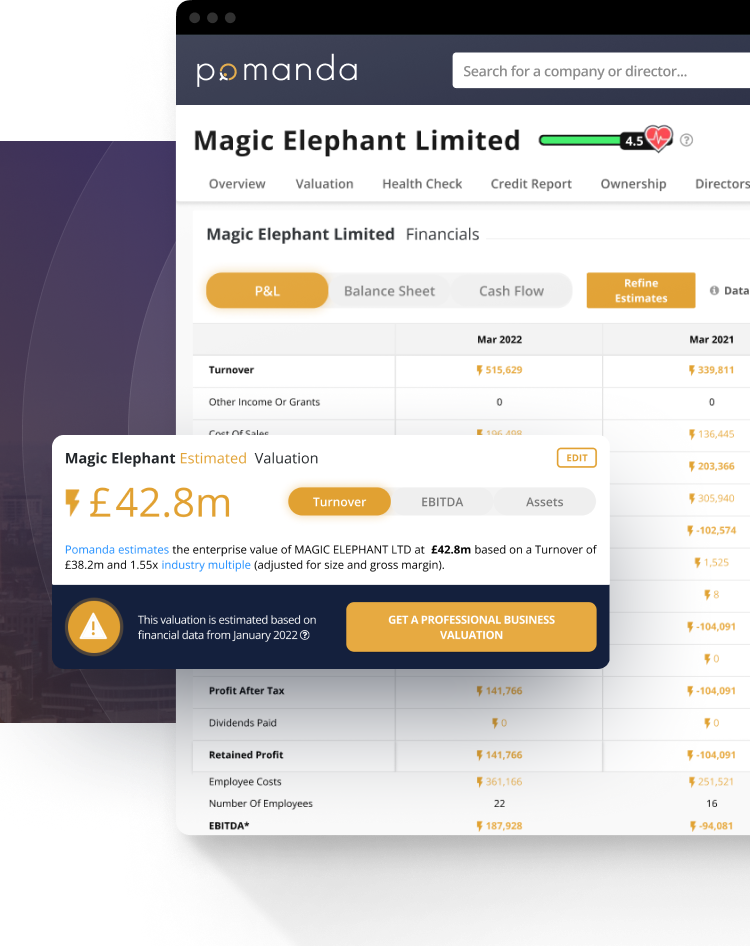Pomanda's Estimates

Understanding Our Estimates
Why & When We Calculate Estimates
There are approximately 4,400,000 active companies in the UK (at the time of writing). Of those, only 220,000 file profit & loss information. If a company doesn’t meet certain thresholds, such as sales of more than £10.2m for more than 2 years running*, having more than 50 employees* and having total assets of more than £5.1m* then they don’t have to file profit & loss information at Companies House. Most companies don’t meet these thresholds, so don’t file any profit and loss information. This leaves an enormous amount of missing data on UK companies’ turnover, gross profit, staff costs and operating profits.
The size of this missing data set presents a problem when identifying trends and key performance indicators across sectors. Thanks to Pomanda’s estimates for UK companies, it is now possible to understand profit & loss data for any UK company, regardless of whether they file it at Companies House.
*https://www.gov.uk/government/publications/life-of-a-company-annual-requirements/life-of-a-company-part-1-accounts#smallcompany

Our Estimates in Detail
How We Calculate Our Estimates
Pomanda uses company filings, publicly available information, established accounting principles and our unique industry metrics to fill in the gaps left by Companies House. Pomanda looks at what limited data a company does file, such as balance sheet items, as the foundation of our estimates.
Next we look at the industry code for that company (SIC code) which allows us to classify the company and identify the company's peers. We then apply Key Performing Indicators from the company's peers to the filed information to arrive at our estimates.
Formula Example
We use a data-driven approach to estimate a company's turnover by comparing its financial and operational metrics, like Debtor Days, Creditor Days, Stock Days, and Employee numbers, with the averages in its industry. We also conduct individual regression analyses for each of these factors to identify which metric has the most significant impact on the company's turnover within that industry.
One of the calculations that goes into our estimates is the standard formula for calculating a companies debtor days.
Debtor Days =
Trade Debtors
Turnover
365 Days
Using the filed balance sheets at Companies House and Pomanda's Industry Averages we can fill in a large part of this formula.
60*
100
Turnover
365 Days
Re-jigging this formula we can then arrive at an "estimate" for that company's turnover. This is just one of the calculations that Pomanda uses to build out a Company's P&L using estimates and standard accounting principles.
Turnover
100,000
60
/365
)Interpreting Our Estimates

Why Our Estimates Are for Guidance, Not Reliance
Here at Pomanda we’re not big on getting things wrong, but we appreciate that sometimes our estimates can be off the mark.
It’s important to note that our estimates are meant to give insight and provide guidance, rather than be relied upon. Our estimates are calculated based on the balance sheet that smaller companies file at Companies House and are combined with our proprietary sector data.
What this means is that if a company’s SIC classification isn’t overly accurate, then neither will our estimates be. Try updating the industry of the company on our platform to reflect the operations of the business. This will rerun our algorithms and should lead to improved accuracy
Balance Sheets are also only a snapshot in time presented by the company and therefor may also not be an accurate representation of the company. If there has been an anomaly on the balance sheet or unusual behavior, then it will also throw off our estimates.
Executive Summary
Company Description
History & Milestones
Key People
Ownership
Shareholders
Business Vision
Objectives
Industry Insight
Target Market
Customer Personas
Strengths & Weaknesses
Opportunities & Threats
Competitive Analysis
Competitive Analysis- Charts
Products & Services
Pricing Model & Strategy
Customer Acquisition Strategy
Customer Acquisition Channels
Sales Forecast
Business Locations
Key Suppliers
Current & Future Staffing
Financial Projections
Funding Requirements & Uses
Business Valuation
Appendix
Executive Summary
Company Description
History & Milestones
Key People
Ownership
Shareholders
Business Vision
Objectives
Industry Insight
Target Market
Customer Personas
Strengths & Weaknesses
Opportunities & Threats
Competitive Analysis
Competitive Analysis- Charts
Products & Services
Pricing Model & Strategy
Customer Acquisition Strategy
Customer Acquisition Channels
Sales Forecast
Business Locations
Key Suppliers
Current & Future Staffing
Financial Projections
Funding Requirements & Uses
Business Valuation
Appendix





